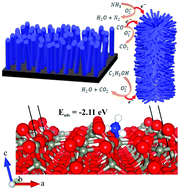Hierarchically interconnected ZnO nanowires for low-temperature-operated reducing gas sensors: experimental and DFT studies†
Abstract
The well-constituted hierarchical arrangement of hexagonal ZnO nanowires with diameters <180 nm and lengths ∼5–6 μm with clearly visible textural boundaries provided a highly porous film of thickness, ∼1300 nm over a large area. The ZnO nanowires delivered excellent sensing performance for CO, C2H5OH, and NH3 reducing gases at a safe detection limit of 50 ppm at an operating temperature of 100 °C. A maximum response of 115% and the response and recovery time of 27 and 9 s, respectively, were recorded for toxic 50 ppm NH3 gas at the operating temperature of 100 °C, which is better than the performance of various previously reported pristine and doped ZnO nanostructures. The experimental observations are corroborated by first-principles density functional theory (DFT) calculations, which were performed to determine the reactivity of gas molecules with hexagonal ZnO nanowires. The expedited sensing response is ascribed to the larger potential barrier offered by the well-interconnected hierarchical growth of hexagonal ZnO nanowires.



 Please wait while we load your content...
Please wait while we load your content...